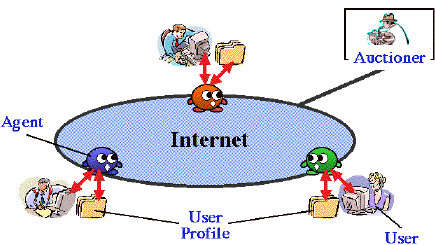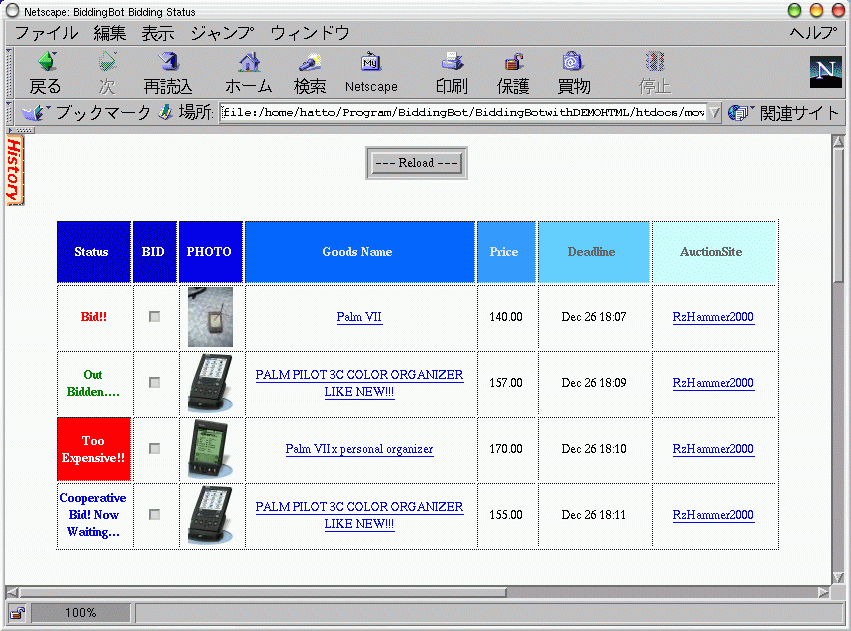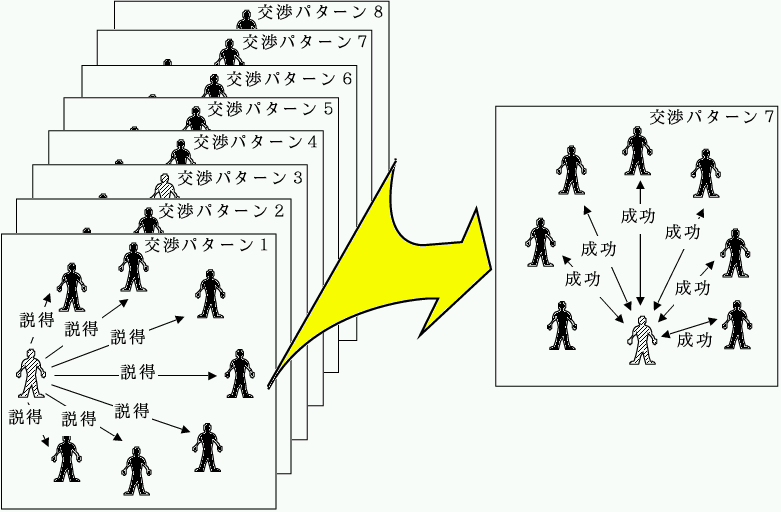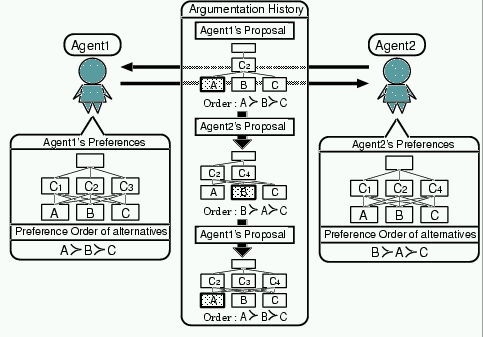
| Today is at the dawn of the new economy. EC(Electronic Commerce) is an important topic of the new economy and has rapidly grown with the expansion of the Internet. In the field of Artificial Intelligence, there have been many researches on EC. In G-Commerce Research Group, we have investigated the electronic market mechanism and effective retail negotiation algorithms using software agents. In the near future, there are many sellers and buyers in Internet. Then, a scale of electronic market will become large. Accordingly, it is difficult to employ existing approach. Currently, we concentrate on the new transaction mechanism called GroupBuy(or GroupSell) and novel multagent-based market system. By realizing the mechanism which support GroupBuy, both of sellers and buyers can trade multiple items efficiently. Moreover, our new multiagent-based market system can provide reasonable and efficient transaction environment. |
 |
|
Fig. A: System-image
|
We have concentrated on following transaction-form: the auction and retail negotiation among agents. Now we are trying to inctroduce a concept of GroupBuy into these transaction-form.
Concretely, We have tried to develop a practical algorithm for cooperative bidding among agents and incorporate into BiddingBot, which is multiagent-based bidding support system. On the other hand, we are elaborating the negotiation method incorporating the GroupBuy. Here, agents make a coalition for increasing expected utilities. For example, when multiple buyer agents buy many same items, they can get a discount (GropuDiscount). And for example, multiple seller agents can make bundles of items and sell each items efficiently by making a coalition. In either case, agents might increase their expected utilities.
Now we actively discuss the algorithm and protocol for obtaining desired result.
Determining the bidding strategy is an important research topic on Internet Auctions. There have been many studies on determining the strategy for maximizing the expected utilities.
We have focused on auction protocols that can incorporate complementary/substitutional preferences on multiple items. Currently, we are elaborating the method to find the optimal bidding strategy in sequential auctions, using a dynamic programming(DP) technique. In previous work, the representation of user's preference is redundant. So, the larger the initial endowment of money becomes, the more time-consuming the calculation of the optimal bidding strategy gets.
In our work, we propose new problem formalization based on a quasi-linear utility for speed-up in computation time. By assuming a quasi-linear utility, the payment can be represented as a state-transition cost. Accordingly, we can avoid explicitly representing the remaining endowment of money. Concretely, when the initial endowment of money is m, we can obtain more than an m-fold speed-up in the computaiton time.
Now, we are trying to determine the optimal bidding strategy based on a bidding history and introduce our proposed method into BiddingBot.
 |
|
Fig. B: An example of bidding
|
In the full autonomous bidding mechanism, agents are completely autonomous and bid autonomously. When a certain agent obtains the item, other agents stop participating in the remaining auctions.
The switching bidding mechanism can prevent agents obtaining multiple same items. In this mechanism, one agent, which has the highest expected utility for bids, is selected from all of agents at each time to bid.
In the hybrid autonomous bidding mechanism, agents employ a bidding mechanism which integrates the full autonomous bidding mechanism and the switching bidding mechanism. Firstly, each of agents autonomously bids in his/her auction site. Near a deadline of a certain auction, agents cooperatively negotiate. Then, one of agents is selected as an agent who can continues to bid. Namely, in this mechanism, one agent concentrates to bid to increase the expected utility for bids.
 |
|
Fig. C: Providing Virtual Auction Services
|
MultiHammer consists of an auction agent, a data storing agent, and several information collecting agents, each of whom is assigned to an auction site. The information collecting agents cooperatively and simultaneously gather information. The data storing agent stores the information to a database. The auction agent provides online auction services using the stored information. By recording the activities in auction sites, MultiHammer can recreate any situation and trace auction for experimentation.
In MultiHammer, each of the information collecting agents works specifically at its auction site and can behave as a flexible wrapper, because different sites present information in different forms. We focus on the gathering mechanism of information collecting agents. These agents work as wrappers not only for collecting information, but also for sending information(e.g., querying or bidding for items). Using these abilities, users can search for items and bid on them using auction agents.
In general, several existing gropu decision support systems use a voting method, which is a method for social decision-making. But the result of voting are often inconsistent. Therefore, we propose a persuasion mechanism rather than voting methods for negotiation among agents. In this mechanism, there are two agent types: "Persuader" and "Compromiser". The outline of the persuasion is as follows:
The agent's belief is a decision hierarchy of the AHP(Analytic Hierarchy Process) based on its user's subjective judgements. We incorporate the persuasion mechanism into the GCDSS(Group Choice Design Support System).
Nemawashi(Ground Work)
In the group decision-making, there exists the trade-off between "reaching a consensus" and "reflecting users' preferences". In order to improve this trade-off, we propose a "Nemawashi" mechanism among agents. Nemawashi is a Japanese negotiation method for maneuvering behind the scenes, lobbying, and so on. By using the Nemawashi mechanism, candidate alternatives are effectively narrowed down. Furthermore, since in this mechanism agents exchange information on thier preferences during the negotiation, the quality of group decision making can be improved.
 |
|
Fig. D: An example of the multiple negotiation
|
In the multiple negotiations, each agent has an opportunity for persuading the others by conducting all patterns of negotiation. For example, if there exist six agents, six patterns of negotiation are conducted.
In the GCDSS(Group Choice Design Support System), we employed multiple negotiations. In the multiple negotiations, all patterns of negotiation should be conducted concurrently in order to facilitate the multiple negotiations. The multiple negotiations can be described as follows: First, each agent dispatches his clones to the other computers. Second, agents negotiate with each other based on persuasion. Finally, each clone returns to the original host in order to report the results of the negotiation.
When agent negotiates on behalf of its user, the user want to reflect his preference effectively durinng negotiation. The typical negotiation protocols (e.g., Contract Net Protocol) are not appropriate for reflecting user's preferences. Recently, interest in argumentation-based negotiation among agents has been growing. An Argumentation-based Negotiation is defined as a continuous process for exchanging proposals and counter proposals. Each proposal consists of a claim and justifications.
Existing theoretical frameworks represent userÕs preference based on logical formulas. However, itÕs extremely complicate to translate human's preferences into logical formulas. Therefore, we are trying to develop a new argumentation method which is not based on a logical framework. Concretely, we developed the argumentation-based negotiation method that uses the quantified user's preferences. In this method, agents can make proposals and counter-proposals based on its AHP-hierarchy which is constructed during the AHP method.
 |
|
Fig. E: An example of argumentation among two agents
|